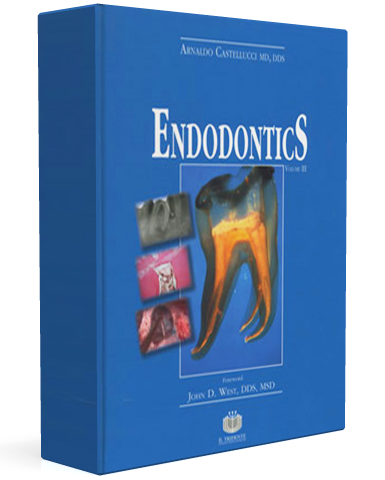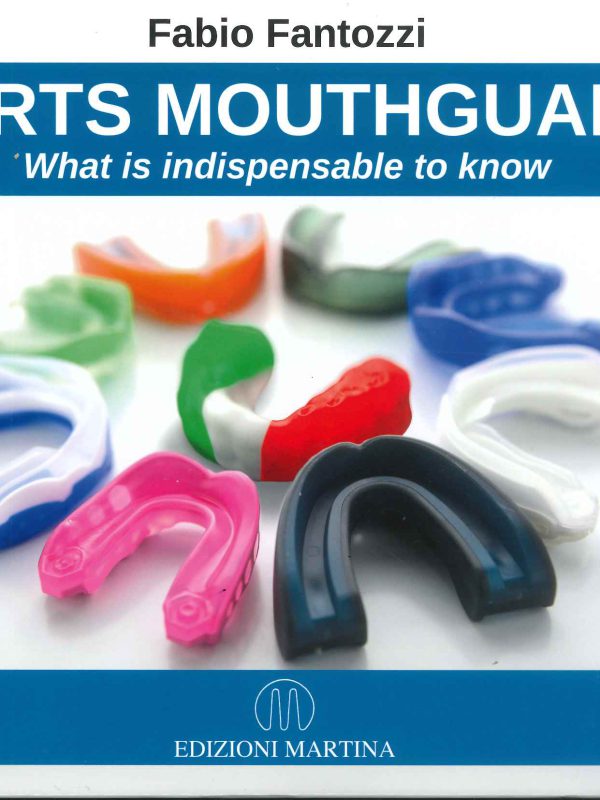Descrizione
CASTELLUCCI A.
ENDODONTICS -Vol. 3
RICCARDO BECCIANI, MD, DDS
Visiting Professor of Restorative Dentistry, University of Siena Dental School, Siena, Italy, during 2002-2006. Active Member of the Italian Society of Endodontics and of the Italian Academy of Restorative Dentistry. Private practice limited to Prosthetics and Restorative Dentistry, Florence, Italy.
GARY B. CARR, DDS, MSD
Founder and Director, Pacific Endodontic Research Foundation, San Diego, California, USA; Lecturer, University of California at Los Angeles; Consultant in Endodontics, VA Medical Center Long Beach, California; Diplomate, American Board of Endodontics.
ARNALDO CASTELLUCCI, MD, DDS
Visiting Professor of Clinical Endodontics, University of Florence Dental School. Italy; President, Warm Gutta-Percha Study Club; Founder and Director Micro-Endodontic Training Center, Florence, Italy.
RONAL R. LEMON, DMD
Associate Dean of Advanced Education and Endodontic Program Director at the UNLV, School of Dental Medicine, Las Vegas, NV
CLIFFORD J. RUDDLE, DDS, FACD, FICD
Assistant Professor, Department of Graduate Endodontics, Loma Linda University, Loma Linda, CA, USA; Adjunct Assistant Professor, Department of Endodontics University of the Pacific School of Dentistry, San Francisco, CA, USA; Consultant Department of Graduate Endodontics Long Beach Veterans Medical Center, Long Beach, CA. USA.
JOHN J. STROPKO, DDS
Private Practice of Endodontics, Scottsdale, Arizona, USA; Visiting Clinical Instructor, Pacific Endodontic Research Foundation, San Diego, California; Adjunct Assistant Professor Graduate Endodontics Goldman School of Dental Medicine, Boston, Massachusetts; Assistant Professor Graduate Clinical Endodontics Loma Linda University School of Dentistry, Loma Linda, California; Instructor and Co-Founder Clinical Endodontic Seminars, Scottsdale, Arizona.
Volume III
CHAPTER 28
ENDODONTIC-PERIODONTIC INTERRELATIONSHIP
ARNALDO CASTELLUCCI
Endodontic-Periodontal Communications
Apical foramen
Lateral canals
Dentinal tubules
Etiologic classification of the Endodontic and Periodontal diseases of the attachment apparatus
1. Primary endodontic lesion
2. Primary endodontic lesion with secondary periodontal involvement
3. Primary periodontal lesion
4. Primary periodontal lesion with secondary endodontic involvement
5. Coexisting primary endodontic endodontic and primary periodontal lesions
6. “True” combined lesion
Healing potential and prognosis
Differential diagnosis and treatment plan
The influence of pulp disease on the periodontium
The influence of endodontic therapy on the periodontium
Perforations
Root fracture
The influence of periodontal disease on the endodontium. The influence of periodontal therapy on the endodontium.
Bibliography
CHAPTER 29
TREATMENT OF TEETH WITH IMMATURE APICES
ARNALDO CASTELLUCCI
Apexogenesis
Apexogenesis with calcium hydroxide
The role of calcium hydroxide
Apexogenesis with Mineral Trioxide Aggregate
Apexification
Technique
Types of apical closure
Histology of the apical barrier
The role of calcium hydroxide
Techniques of obturation
Apical barrier technique
Prognosis
Bibliography
CHAPTER 30
ROOT RESORPTION
ARNALDO CASTELLUCCI
Inflammatory resorption
Transient inflammatory resorption
Progressive inflammatory resorption
Resorption secondary to pressure
Resorption secondary to infection
Internal resorption
External
Resorption with ankylosis and replacement
Extracanal invasive resorption
Bibliography
CHAPTER 31
BLEACHING NON VITAL AND VITAL TEETH
ARNALDO CASTELLUCCI AND RONAL R. LEMON
Section I:
Bleaching non vital teeth
Classification
Genetic discolorations
Metabolic discolorations
Medicine-related discolorations
Causes of pigmentation of pulpless or endodontically treated teeth.
Pulpal hemorrhage
Decomposition of pulp tissue
Intracanal medicamento and sealers
Restorative materials
Contraindications
Bleaching agents
Hydrogen peroxide
Sodium perborate
Preparation of the tooth
Bleaching techniques
Walking bleach
Thermocatalytic technique
Combined technique
Final obturation
Prognosis
Complications
Guidelines for the prevention of discoloration
Section II:
Bleaching vital teeth
Dental lightening procedures
Stains of enamel and dentin. Treatment considerations
Fluorosis stains
Etiology
Diagnosis
Treatment
Special considerations: orthodontics and bonding
Combination procedures
Microabrasion and developmental enamel defects.
Tetracycline stains
Etiology
Diagnosis and treatment planning
Treatment
Special considerations
Physiologic stains
Etiology
Diagnosis
Development of vital bleaching techniques
Treatment planning
Treatment
Special considerations
Exogenous (calculus-like) stains
Combination procedures
Incorporating dental lightening procedures into practice.
Bibliography
CHAPTER 32
THE USE OF THE OPERATING MICROSCOPE IN ENDODONTICS
GARY B. CARR AND ARNALDO CASTELLUCCI
Introduction
On the relative size of things
The limits of human vision
Why enhanced vision is necessary in dentistry
Optical principles
Loupes
The problem of light
The operating microscope in endodontics
The anatomy of the surgical operating microscope
The supporting structure
The body of the microscope
The light source
Accessories
The laws of ergonomics
Positioning the microscope
Ergonomics and the microscope
The use of the operating microscope in endodontics
Diagnosis
Locating the canal orifices
Retreatment
Surgical endodontics
Learning curve
Conclusion
The future
Bibliography
CHAPTER 33
NONSURGICAL ENDODONTIC RETREATMENT
CLIFFORD J. RUDDLE
Introduction and definition
Foreword
Rational for retreatment
Criteria for success
Nonsurgical versus surgical retreatment
Factors influencing retreatment decisions
Coronal disassembly
Factors influencing restorative removal
Coronal disassembly devices
Post removal
Factors influencing post removal
Techniques for post removal
Nonmetallic post removal
Removal of obturation materials
Gutta-percha removal
Silver point removal
Carrier based gutta-percha removal
Paste removal
Broken instrument removal
Factors influencing broken instrument removal
Coronal and radicular access
Techniques for removing broken instruments
Blocks, ledges and apical transportations
Techniques for managing blocks
Techniques for managing ledges
Techniques for managing apical transportations.
Endodontic perforations
Considerations influencing perforation repair
Materials utilized in perforation repair
Techniques for repairing perforations
Missed canals
Canal anatomy
Armamentarium and techniques
Future
Bibliography
CHAPTER 34
MICRO-SURGICAL ENDODONTICS
JOHN J. STROPKO
Introduction
Microscopes and endoscopes for enhanced vision.
Endodontic Surgery or Surgical Endodontics
Indications for surgical endodontics
Contraindications for surgical endodontics
Lateral lesions of endodontic origin
Unfavorable crown-root ratio
Vertical root fractures
Medical considerations
Past medical history
Antibiotic medication
Anti-inflammatory medications
Psychological considerations
Section I:
Preparation of the patient, surgical team and Instruments
Preparation of the patient
Preparation of the surgical team
Preparation of the instruments
Local anesthesia
Hemostasis staging
Toilet and stabilization of the surgical site
Section II:
The incision and atraumatic flap elevation
Anatomical considerations for incision
Inferior alveolar nerve
Mental nerve
Greater palatine artery
The incision
Reflection of the flap
Atraumatic flap retraction
Section III:
Access and crypt management
Access
Crypt management
Ferric sulfate
Slight hemorrhaging
Moderate hemorrhaging
Calcium sulfate
Severe hemorrhaging
Section IV:
The root-end bevel and root-end preparation
The root-end bevel
Methylene blue staining
Ultrasonic root-end preparation
Section V:
Root-end filling
Root-end filling materials
SuperEBA
Bonding
Mineral Trioxide Aggregate
Optional microsurgical procedures
Trans-sinus apical surgery
Pre-surgical restorations
Prior to root resection
Prior to root-end resection
Surgical repair of perforation or resorption defects.
Guided bone regeneration
Materials for GBR
Calcium sulfate
Section VI:
Sutures and suturing techniques
Closure of the surgical flap
Suturing technique using the surgical operating microscope.
Suturing considerations
Flap tissue: re-approximation management
24 hour suture removal
Postoperative care
Post surgical home care.
Conclusion
Bibliography
CHAPTER 35
RESTORATION OF THE ENDODONTICALLY TREATED TOOTH
RICCARDO BECCIANI
Introduction
History
Biomechanics
Operative sequence
Preliminary data collection and evaluation
Treatment plan
Materials and techniques
1) Posts
Prefabricated posts
Cast post and core
2) Cements for posts cementation
3) Prosthetic crowns
4) Conservative restorations
Amalgam
Glass ionomer cements
Composite and the adhesive technique.
Severely periodontally compromised teeth
Chapter outline
Bibliography




